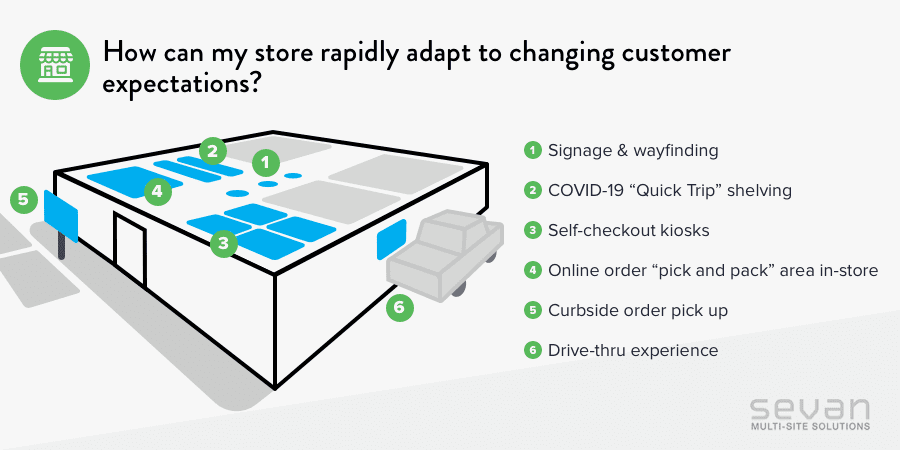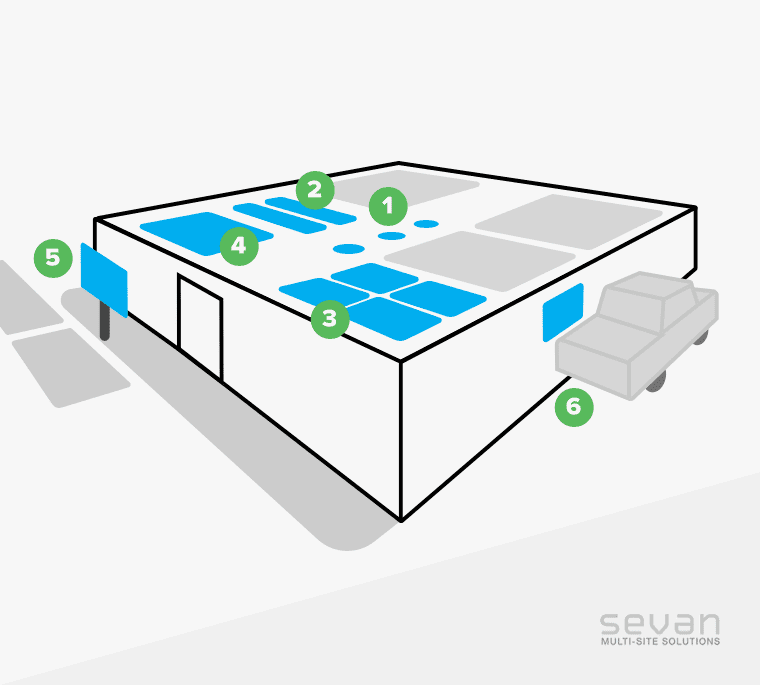The impact of the Coronavirus on shopping behavior and store updates has been swift and dramatic. Stores not forced to close during the outbreak have rapidly revamped their models to adapt to changing customer expectations and health and safety needs.
These latest shopping trends are primarily targeted toward reducing person-to-person interactions. By helping guests safely navigate their shopping journey—from online to curbside to on-site—stores are improving the customer experience. Based on the COVID-19 impact on shopping behavior, multi-site owners are making store design updates to accommodate changes in shopping experiences to address both convenience and safety.
What Impact has COVID-19 Had On Shopping Behavior?
Store traffic patterns and customer behaviors are always changing, but the Coronavirus’ impact on shopping behavior is unprecedented. According to Numerator’s weekly COVID-19 consumer analysis, 89% of consumers have changed their shopping habits. In response to several behavior questions, respondents reported that:
- 61% are eating out less frequently
- 53% are delaying purchases
- 31% are stocking up on products they wouldn’t normally stock-up on
- 31% are making online purchases
- 33% made their first “click and collect” order
Multi-site businesses are taking note and making the necessary changes to adapt to these behaviors.
6 Ways Stores Are Adapting To Changing Customer Expectations
In the span of weeks, grocery stores, pharmacies, gas stations, hardware stores, and other essential retailers have made numerous modifications to the shopping experience. Shopper expectations are shaping these updates, which support social distancing and decrease the time each shopping interaction takes.
Here are six ways stores are adapting to the Coronavirus’ impact on shopping behaviors.

Signage and Wayfinding
While there are distinct patterns arising from the Coronavirus’ impact, not every shopper will adapt at the same speed. Be sure to communicate new shopping patterns and store changes with static or electronic / digital signage on the exterior and interior of the store. In addition, use wayfinding and social distancing signage throughout the store to direct traffic flows and politely remind guests of others’ expectations.
If stores temporarily close, signage should be used to direct guests to the nearest alternative.
COVID-19 “Quick-Trip” Shelving
Accommodate guests looking for specific items with limited exposure by installing a quick service area in the store. For pharmacies, these items may include thermometers, medicines, and other essentials. Multi-site managers have the added benefit of improved consumer analytics, allowing for more data-driven decisions as to what belongs on the quick-trip shelves.
As an added benefit, use the quick-trip shelving to strategically direct traffic into a self-checkout kiosk.
Self-Checkout Kiosks
Increasing the number of self-checkout stations reduces person-to-person shopping. It also minimizes lengthy queueing and improves convenience. Self-checkout kiosks are also a strategic way to manage employee resources, ensuring employees are readily available for the most pressing staff-to-guest interactions.
Maintain a safe environment by cleaning self-serve kiosks between uses with sanitizing wipes to help reduce lingering pathogens.
Online Order “Pick and Pack” Area In-Store
The demand for “Buy online, pickup in store” (BOPIS) has risen as consumers are limiting their public contact. In response to these changing behaviors, store owners can create or expand a dedicated space for associates to “pick and pack.” For grocers and food retailers, it is beneficial to provide additional refrigerators and freezers to accommodate increased orders and a higher throughput.
“Pick and pack” for online orders is an efficient method to reduce in-store activity while still meeting consumer demands.
Curbside Order Pick-Up
One of the latest shopping trends to develop is the utilization of curbside order pick-up. This method for limiting public contact has been adopted by grocery stores, hardware stores, restaurants, and other essential businesses in the wake of the COVID-19 outbreak.
Adding dedicated parking spaces or a curbside pickup directional signage provides a great customer experience while reducing exposure.
Drive-Through Experience
Consumers are using drive-throughs now more than ever. Restaurants and pharmacies are expanding their drive-through lanes to accommodate the increased demand. For restaurant or pharmacy drive-throughs, ensure adequate space is available for longer lines. Also ensure to staff appropriately to support the increased activity without drastically increasing wait times.
Help consumers know you have drive-through options available by updating your website or store app with the latest information.
Preparedness Helps Protect Health and Safety
The impact of COVID-19 on shopping behavior is significant, and businesses must remain flexible as new needs, recommendations, and expectations arise. Multi-site owners can make a direct impact on consumers’ health and safety by preparing their locations to accommodate consumers expectations today and into the future.
Contact Sevan To Discuss Project Planning
For more safety tips and solutions to provide peace of mind to your associates and consumers, download the complete COVID-19 Biological Defense Preparedness Guide.


As everything becomes more expensive by the day, a middle man is challenged to bear their costs. Help the next generation by coupons. Shop Now and Save Now.
Thank you
Specialists with extensive experience with MCA Sales Leads can perplex the second-best Best Merchant Cash Advance Leads. That is why we sought to alter the rules. Qualified Merchant Cash Advance Leads that will help you close deals.